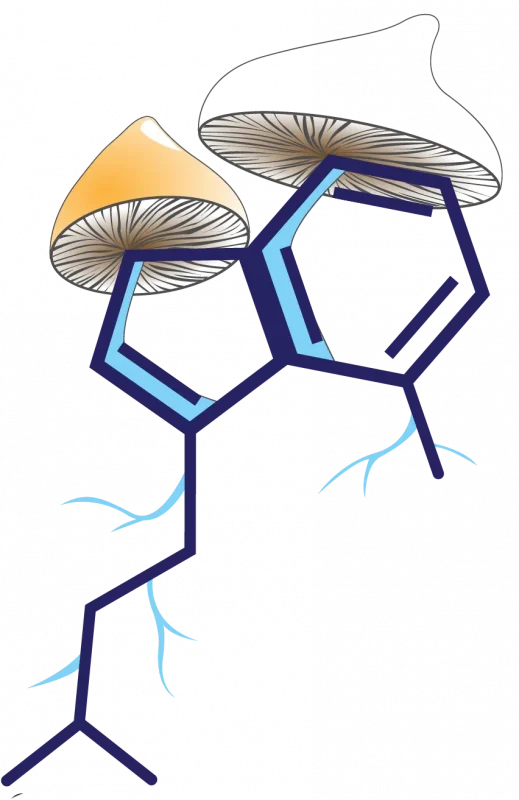Lysergic Acid Diethylamide (LSD), a potent hallucinogenic agent, carries a substantial cultural and scientific legacy since its inception in 1938. Acknowledged for potential therapeutic applications and profound psychological influences, it also presents risks and side effects varying from mild discomfort to severity. This composition endeavors to illuminate the scientific understanding of the risks and side effects associated with LSD consumption.
LSD’s Neurochemical Dynamics
Predominantly acting on serotonin receptors in the brain, with a particular affinity for the 5-HT2A receptor, LSD influences numerous psychological and physiological functions. This explains the wide range of effects LSD manifests on perception, mood, and cognition. Its stimulation of these receptors can heighten neuronal activity and connectivity, possibly causing hallucinogenic effects. However, this modified brain function may contribute to the risks and side effects associated with LSD usage, as suggested by various studies, including the one by Preller and colleagues published in Neuropsychopharmacology (2017).
LSD’s Immediate Physical Side Effects
LSD’s immediate physical consequences encompass elevated heart rate, blood pressure, and body temperature, pupil dilation, sweating, dry mouth, and tremors. While typically harmless for healthy individuals, these effects could pose significant risks for individuals with underlying heart or other health complications. Studies, like the one published in Drug and Alcohol Dependence (2015), report these physical side effects of LSD.
LSD’s Immediate Psychological Side Effects
Beyond physical manifestations, LSD can induce a spectrum of psychological effects, including hallucinations, distorted perceptions of time and space, amplified emotions, anxiety, and paranoia. Despite many individuals resorting to LSD for positive psychological experiences, these effects can be distressing and overwhelming, as documented in scientific literature, such as in the Journal of Psychopharmacology (2016).
Long-Term Hazards of LSD Consumption
While acute effects of LSD are relatively comprehensible, its potential long-term risks remain under active research. Possible enduring effects encompass persistent psychosis, including mood fluctuations and visual disturbances, and Hallucinogen Persisting Perception Disorder (HPPD), marked by constant sensory disturbances, primarily visual. Studies like the one published in Therapeutic Advances in Psychopharmacology (2018) provide an in-depth account of potential long-term effects of LSD usage.
The Peril of Unpleasant Trips
A considerable risk tied to LSD usage is the possibility of an unpleasant trip, characterized by intense negative emotions such as fear, paranoia, and panic, alongside horrifying hallucinations. Unpleasant trips can be psychologically distressing and potentially traumatizing. Research indicates that the mental state (set) and environment (setting) significantly influence the likelihood of an unpleasant trip, as detailed in a study in the Journal of Psychopharmacology (2017).
LSD Consumption and Mental Health Conditions
LSD consumption can be particularly risky for individuals with pre-existing mental health conditions like schizophrenia, bipolar disorder, and severe depression. LSD can intensify symptoms of these disorders and potentially induce a psychotic episode in those predisposed to such conditions, as implied by a review in Schizophrenia Bulletin (2016).
Navigating the Hazards: Harm Reduction Measures
Given these potential risks and side effects, the discussion of harm reduction measures becomes crucial for individuals choosing to consume LSD. Such measures could include “trip sitting,” ensuring a safe and comfortable environment, mental preparation, and initiating with a low dose. Studies such as the one published in the Journal of Psychopharmacology (2018) demonstrate that these strategies can significantly mitigate risks linked to psychedelic usage.
Conclusion
While LSD can facilitate profound experiences and harbor potential therapeutic benefits, awareness of its possible risks and side effects is paramount. By comprehending the science behind these effects and adopting harm reduction measures, individuals can make more informed decisions about LSD usage. Continued research remains critical for entirely understanding the long-term impacts of LSD consumption and devising more effective risk mitigation strategies.
[gap height=”130px”]
[ux_image id=”8401″]
[gap height=”130px”]
We hope that you have gained a little more understanding and wisdom after reading through our article about LSD. We hope that it has inspired you to explore the multitude of possibilities through LSD.
Shroomhub is your trusted online source in Canada for all things Psychedelic, from Magic Mushrooms, LSD and even DMT, take advantage of our weekly deals and bargain prices you wont find anywhere else!
[gap height=”130px”]
[message_box]
[row v_align=”middle” h_align=”center”]
[col span=”9″ span__sm=”12″]
Author
Freelance Writer
Leo Thomas
[/col]
[col span=”2″ span__sm=”12″ align=”center”]
[button text=”Linkedin” color=”white” style=”outline” radius=”99″ link=”https://www.linkedin.com/in/leo-thomas-24b827279/”]
[/col]
[/row]
[/message_box]





